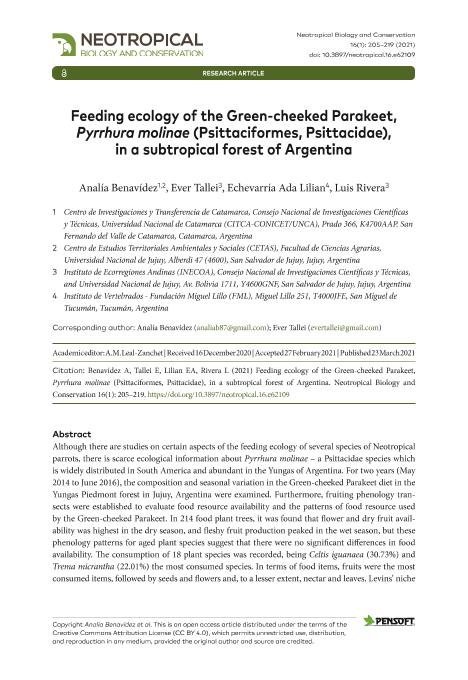Artículo
Feeding ecology of the green-cheeked parakeet, pyrrhura molinae (Psittaciformes, psittacidae), in a subtropical forest of Argentina
Fecha de publicación:
02/2021
Editorial:
Universidade do Vale do Rio dos Sinos
Revista:
Neotropical Biology and Conservation
ISSN:
2236-3777
Idioma:
Inglés
Tipo de recurso:
Artículo publicado
Clasificación temática:
Resumen
Although there are studies on certain aspects of the feeding ecology of several species of Neotropical parrots, there is scarce ecological information about Pyrrhura molinae – a Psittacidae species which is widely distributed in South America and abundant in the Yungas of Argentina. For two years (May 2014 to June 2016), the composition and seasonal variation in the Green-cheeked Parakeet diet in the Yungas Piedmont forest in Jujuy, Argentina were examined. Furthermore, fruiting phenology transects were established to evaluate food resource availability and the patterns of food resource used by the Green-cheeked Parakeet. In 214 food plant trees, it was found that flower and dry fruit availability was highest in the dry season, and fleshy fruit production peaked in the wet season, but these phenology patterns for aged plant species suggest that there were no significant differences in food availability. The consumption of 18 plant species was recorded, being Celtis iguanaea (30.73%) and Trema micrantha (22.01%) the most consumed species. In terms of food items, fruits were the most consumed items, followed by seeds and flowers and, to a lesser extent, nectar and leaves. Levins’ niche breadth showed varying levels of diet specialisation amongst seasons, which was narrower (B = 0.28) in the wet season, indicating specialisation in diet during this season. There was a medium overlap in parakeet diet between seasons (Morisita Index = 0.59). We did not find a statistically significant relationship between resource availability and food use, but expansion and contraction in Levins Index and variation in food items consumed throughout the year and season demonstrate high flexibility in the diet. Like other congeners, the Green-cheeked Parakeet has a flexible diet that could be adjusted to the seasonal availability of food resources. These data may contribute to the design of conservation plans for the species and its habitat.
Palabras clave:
DIET
,
NICHE BREADTH
,
NON-PASSERINES
,
PIEDMONT FOREST
,
SEASONALITY
,
YUNGAS
Archivos asociados
Licencia
Identificadores
Colecciones
Articulos(INECOA)
Articulos de INSTITUTO DE ECORREGIONES ANDINAS
Articulos de INSTITUTO DE ECORREGIONES ANDINAS
Articulos(SEDE CENTRAL)
Articulos de SEDE CENTRAL
Articulos de SEDE CENTRAL
Citación
Benavídez, Analía; Tallei, Ever Denis; Echevarria, Ada Lilian; Rivera, Luis Osvaldo; Feeding ecology of the green-cheeked parakeet, pyrrhura molinae (Psittaciformes, psittacidae), in a subtropical forest of Argentina; Universidade do Vale do Rio dos Sinos; Neotropical Biology and Conservation; 16; 1; 2-2021; 205-219
Compartir
Altmétricas




